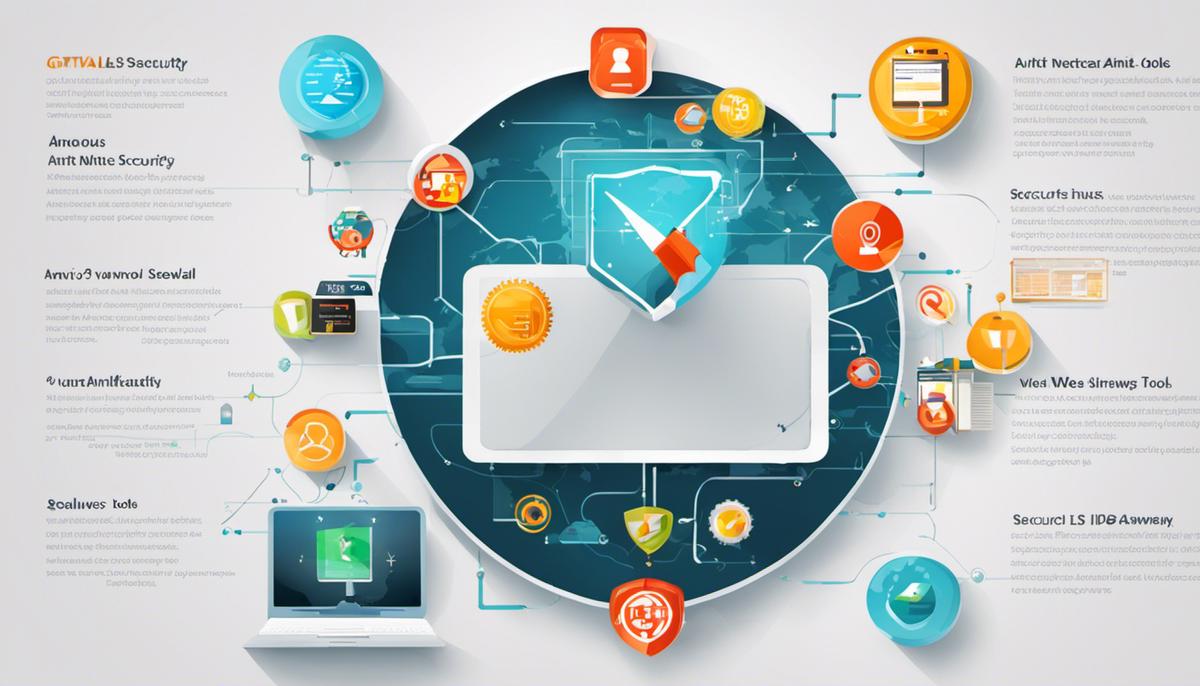Network security tools play an indispensable role in maintaining data integrity and thwarting potentially disastrous threats. The need for networking security tools and their intricate functionality is a golden thread that runs through the fabric of all successful online operations. Regardless of whether it’s a multinational corporation or a simple personal computer, these tools form the bulwark against data breaches, unauthorized access, and other forms of digital vulnerabilities. This discourse will provide invaluable insights into various network security tools, their classification and specificities, and the future direction this critical technology is heading towards. It will also serve as a practical guide for those seeking to implement these tools optimally in their systems.
Understanding the Need for Network Security Tools
The Indispensability of Networking Security Tools in Today’s Tech Era
In an era dominated by remarkable technological advancements and digital transformation, every piece of data is a goldmine. From securing sensitive info to maintaining smooth workflows, everything hinges on robust networking security tools. These cybersecurity sleuths have become the unspoken heroes of the tech landscape. But why are they growing exponentially in significance? Let’s unravel it.
First and foremost, there is a spike in data breaches. The boom in the digital ecosystem has set a welcoming stage for data robbers to exploit vulnerable networks. The frequency of cyber threats and data leaks has skyrocketed, with malevolent entities becoming increasingly sophisticated. Networking security tools provide the shield needed to reflect these attacks and ensure the preservation of private and sensitive data.
Second, the eruption of IoT devices. The proliferation of interconnected appliances, gadgets, and systems has demanded a shift towards efficient networking security tools. It’s an IoT world out there. From controlling home lighting systems to managing industrial operations, IoT is everywhere. This interconnectivity between myriad devices opens a window for hackers to infiltrate systems, making top-notch network security tools paramount for defense.
Third, stringent regulatory requirements. Governments worldwide are coming down hard on data privacy, with laws enforcing stringent protection strategies. Non-compliance might result in multi-million dollar penalties. That’s where networking security tools step in, ensuring regulatory compliance and safeguarding the enterprise from hefty fines and tarnished reputations.
Fourth, the extensive adoption of cloud technologies. As businesses eschew traditional modes of operation for the cloud, there’s a shift from perimeter-based to zero-trust security architectures. This has made accurate visibility of network activity NOT a nice-to-have but an absolute necessity, thereby increasing the demand for efficient networking security tools.
Finally, the dramatic shift to remote working. COVID-19 was a game-changer in the way businesses conducted their operations. Remote work exploded, and suddenly, enterprises were no longer bound by physical office spaces. This geographical dispersal of IT infrastructure amplified the complexity of maintaining data security. Networking security tools came into the spotlight to provide comprehensive coverage for businesses and to nip threats in the bud.
The conclusion is straightforward. Networking security tools have secured a seat at the crux of this tech-driven world. Its potency in resisting data breaches, supporting IoT devices, ensuring regulatory compliance, adapting to cloud technologies, and managing remote workplaces makes it an indispensable comrade in every tech enthusiast’s arsenal.
Remember – in this tech era, we’re only as strong as our defensive line. Cybersecurity is not a luxury; it’s a business, nay, a global necessity. So, here’s to harnessing the power of networking security tools for a more secure, safe, and seamlessly digitized world.

Classification of Network Security Tools
Diving Deeper into Networking Security Tools: The Primary Categories
In a digital world punctuated by data breaches and an explosion of Internet of Things (IoT) devices, the need for robust network security is paramount. As more businesses adopt cloud technologies and remote working becomes the norm, so does the pressing need to guard these neo-networking landscapes. In order to effectively safeguard these ever-evolving cyber surroundings, it is essential to understand the primary categories of networking security tools.
Firewalls: Your First Line of Defense
Firewalls regulate traffic between systems or networks through rules and protocols. This ‘guardian of the gateway’ inspects data packets, acting as a filter between a trusted and untrusted network. Consequently, firewalls prevent unauthorized access, protect internal resources, and block outgoing malicious activity.
Anti-virus Tools: The Classic Shield
Historically, anti-virus tools have always been a key component of network security. By periodically scanning the system and comparing files and software against a database of known threats, these tools detect and remove malicious entities. Although their scope has been somewhat outpaced by advanced threats, they remain vital for basic network security hygiene.
Intrusion Detection and Prevention Systems (IDS/IPS)
IDS tools continuously monitor network traffic for any unusual or suspicious activity. When detected, they alert administrators, who then apply protective measures. Under the IPS umbrella, these systems are designed to not only identify threats but also to block them from escalating.
Secure Web Gateways
With a significant rise in web threats, Secure Web Gateways have emerged as an important form of network security. They prevent data leaks, control data usage, and provide protection against malicious web content. Positioned between users and the broader internet, they monitor and filter internet-borne threats.
Security Analytics Tools
In the face of increasingly complex cyber threats, Security Analytics Tools employ artificial intelligence and machine learning to detect anomalies. They aggregate and analyze data correlating seemingly unrelated events to identify hidden patterns, thus paving the way for proactive threat detection and mitigation.
Network Segmentation Tools
These tools separate a network into smaller parts, each with its own set of rules and controls. In the event of a threat, network segmentation tools prevent the intrusion from spreading throughout the network. This limits the threat landscape and makes recovery much quicker and simpler.
VPN Tools
Virtual Private Network (VPN) tools encrypt network traffic, ensuring secure remote access and data transfer. Especially relevant to the vast, remote working landscape, VPNs are key for businesses with dispersed teams accessing the network from various locations.
Understanding these categories of networking security tools is the first step toward deploying them effectively. Alongside an educated user base, the right combination of these tools can build a robust defense network ready for the digital challenges of today and tomorrow.

In-depth understanding of different Network Security Tools
Moving further into the expansive world of network security tools, there are still loads of robust gears lying and waiting in the arsenal behind the scenes. These tools, part of any tech enthusiast’s dream vault, pride themselves on their unique capabilities and functionalities. Here, we’ll dig into Data Loss Prevention (DLP) Tools, Anomaly and Behavioral Detection Systems, and Advanced Threat Protection Systems, each of which brings its own coveted set of skills to the table.
DLP tools are a crucial line of defense in the cybersecurity realm. These systems meet the challenge of securing sensitive data ecstatically, thwarting any attempt to take data outside a network’s established boundaries. These tools scan data loads leaving the network, preventing unauthorized access by detecting sensitive information such as credit card numbers or social security details. This data sniffing capability has been the saving grace for many enterprises, ensuring their critical data can sleep safely at night.
On the other hand, Anomaly and Behavioral Detection Systems love to go Sherlock Holmes on your network. Avoiding the hodgepodge of traditional security measure signatures, these systems watch your network behavior closely, learning the usual patterns and anomaly indicators. When they detect aberrant activity, it signals an alarm that may indicate a security threat. This AI-centric approach enables finer-grained detection and faster response times, effectively saving your network from potentially harmful activities unaware to human operators.
Advanced Threat Protection Systems are the new poster boys in town, outperforming the traditional tools by leaps and bounds. Fortifying the network against advanced persistent threats (APTs), ransomware, and zero-day exploits is their primary aim. They employ a multitude of techniques, from sandboxing to reputation-based detection, to fulfill their mission. These tools are designed for in-depth defense, alleviating threats that sneak through the outer defense layer.
Network Access Control (NAC) tools are the ever-watchful gatekeepers. Paired with network management tools, NAC systems control the access provided to devices trying to connect to the network. They check devices for compliance with security policies before allowing access, thus preventing potentially compromised devices from permeating the network. They’re essentially the bouncers of a network – stern but invaluable.
Lastly, don’t undervalue the quiet power of Encryption Tools. These systems encode your data with complex cryptographic algorithms before sending it across a network, ensuring that intercepted data becomes useless to cybercriminals. More like a magical cloak, they keep your data under wraps and secure from prying eyes.
So, there it is. A formidable arsenal of network security tools stands ready to protect your cyber world. Each possesses its distinct capabilities and functionalities dedicated to guarding a different aspect of network security. Choosing the right blend of these tools hinges upon your unique needs, offering an ironclad guard against the increasingly audacious threats of the digital world. That’s the beauty of technology; there’s always a solution to a problem – you just have to select the right tool for the job.

The Future of Networking Security Tools
Artificial Intelligence (AI) and Machine Learning (ML) in Network Security
Artificial Intelligence and Machine Learning are making exciting leaps forward in network security. These technologies help in predicting, identifying, and neutralizing threats by understanding patterns and anomalies. AI and ML do not just react to threats, but they forecast them, reinforcing network defenses by staying ahead of the curve. Capable of ‘learning’ from data input without explicit programming, these tools can adapt and respond to network security threats in real-time.
Zero Trust Model
Another trend gaining traction is the zero-trust model. Initial security models operated on the notion of ‘trust but verify’, which no longer holds water in the current landscape of advanced persistent threats. The zero trust model, a product of the evolution of network architectures, works on the principle of ‘never trust, always verify’. Every user, device, and IP address trying to access resources on the network must be authenticated and verified, significantly tightening security.
Deployment of Blockchain in Network Security
Blockchain technology showcases huge potential in network security. With its capability for decentralization, transparency, and immutable records, blockchain can revolutionize security protocols by providing an added protection layer against data tampering and identity theft.
User Entity and Behavior Analytics (UEBA)
This approach of using advanced analytics to identify deviations from established norms brings a behavioral perspective to network security. By examining and interpreting patterns of user behavior, UEBA tools can pinpoint anomalies or malicious activities that traditional tools might overlook. This method not only facilitates the detection of inside threats, compromised credentials, and brute-force attacks but can also help enforce regulatory compliance.
Integration of IT and Operational Technology (OT)
As industries gear towards Industry 4.0, the convergence of IT and OT is imminent. While this integration will undoubtedly yield efficiency and productivity, it also raises significant network security concerns. The challenge lies in combining these two radically different environments without compromising security.
Conclusion of Security Silos
Finally, the merging of different security systems and strategies into a cohesive, combined network security strategy helps eliminate vulnerable links. By closing off security silos and transitioning to a more holistic, integrated model of network security, organizations can fortify their protection against increasingly complex and wide-ranging threats.
Remember, innovation in technology isn’t confined to convenience and efficiency alone. In a landscape where cybersecurity threats evolve and adapt at an equally impressive pace, the future integrity and safety of networks lie in the evolution of network security itself. Innovation and application of new technologies are integral to navigating the unknown waters of future cybersecurity landscapes.

Implementing Network Security Tools
Continuing from an in-depth exploration of how data breaches, IoT devices, and cloud technologies intricacies intertwine with network security, let’s now dive into the best practices for ensuring that network security tools are successfully implemented.
A well-planned cybersecurity strategy is the first pillar of successfully integrating network security tools. This includes the establishment of international standards and frameworks such as ISO/IEC 27001, NIST, and CIS, which provide guidance on risk management and control of information security.
Always stay updated on the latest threats and vulnerabilities. Continuous monitoring and updating of security tools are crucial in an environment where threats evolve rapidly. Utilizing real-time threat intelligence feeds can provide insights into current cyber threats and assist in proactive defense.
Policy enforcement is equally crucial. From comprehensive password policies to the necessary firewall rules and regulations, it is vital to set, enforce and regularly check policies across all resources. Passwords should be unusual and updated regularly, while firewall rules should be restrictive yet functional.
Education is another key aspect in fortifying network security. Teams should be trained not only in responding to breaches and maintaining defenses but also in understanding how threats can infiltrate systems in the first place. Knowledge about phishing scams, social engineering, and other infiltration techniques empowers employees to be more vigilant and less susceptible to these attacks.
Furthermore, these tools should not be utilized in isolation. Instead, they should form an interconnected array of defense components that share information about threats and vulnerabilities. Consider integrating your security tools with a Security Information and Event Management (SIEM) system. SIEM solutions aggregate data from various security tools, providing a holistic view of the organization’s security posture and enabling coordinated responses to security events.
The principle of least privilege should be followed as a foundational cybersecurity strategy. Users should be given a minimal level of access to perform their tasks. This reduces the potential threat surface and decreases the chances of malicious internal actions.
While moving forward using newer security practices such as the Zero Trust Model, AI, ML, and UEBA, never underestimate the power of fundamental security practices such as data encryption, maintaining security backups, and keeping software updated.
Lastly, adopting vulnerability management programs is essential. Regular assessments and penetration testing can identify potential areas of weakness in the network infrastructure, allowing flaws to be addressed before they can be exploited.
In the burgeoning digital landscape, the points emphasized in this piece must not be perceived as exhaustive. Continuous evolution and adaptation of security practices, staying informed about the latest threat landscapes, and maintaining a proactive stance in security training and policies is vital to ensure your network remains resilient in the face of rising security threats. Remember, network security is not a one-time event but a continuous process.

Through the lens of this discourse, we traversed the landscape of network security tools, taking a closer look at their necessity, varied classifications, future trajectory, and careful implementation. As the digital environment continues its rapid evolution, propelled by breakthroughs in Artificial Intelligence and Machine Learning, network security will inevitably become an even more crucial aspect. It is our collective responsibility, whether as tech enthusiasts, general users, or industry mavens, to stay informed and adept in leveraging these security tools. Armed with the knowledge provided here and with a mindful approach towards digital security, we can all contribute to making the digital world a safer space for everyone.

